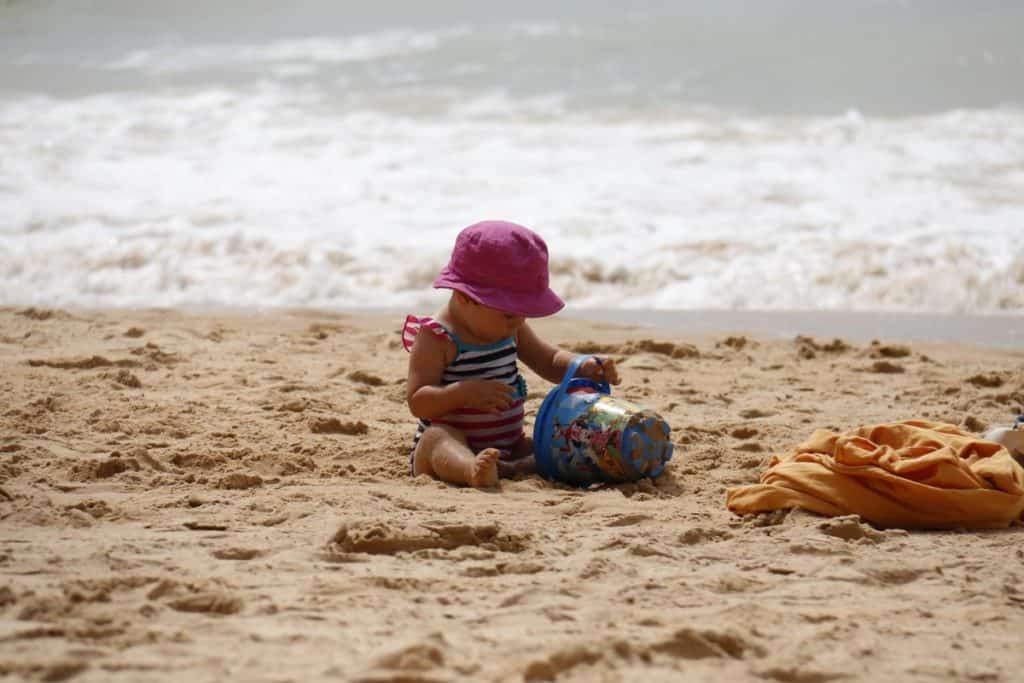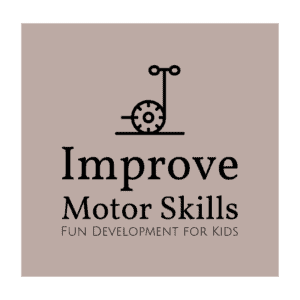Planning to take your toddler to the beach on a warm summer day? That’s great! What’s even better, is that you can introduce them to new activities (that they can’t do at home) to improve their fine motor skills.
Just make sure you apply sunscreen, use protective clothing if the UV index is high, and always keep an eye on your kid.

I have always tried to introduce my daughter to activities that have a specific goal in her development (e.g. fine & gross motor development, sensory development, etc). Going to the beach offers many opportunities to boost your little one’s development in various ways.
So here’s a list of some activities to do with your toddler on the beach with explanations regarding what benefits each activity has on kids’ fine motor skills. The list starts with simpler activities, suitable for younger kids, and moves on to more complex activities that work best for older toddlers.
A Small Bucket for Pouring Water
6+ months
Grabbing water with the bucket and then pouring it out again will develop various grasping and rotational movements of the hand. As kids are ‘built’ for repetitive action, they can stick to one activity for a long time, hence giving a nice boost to their motor skills.
If your kid is not yet ready to go into the ocean or lake water, bring an inflatable pool with you, so they could enjoy the summer day in there.
Floating Toys
6+ months
Bring some floating toys (a boat, ball, rubber duck, etc.) with you when going to the beach. They will be fun and age-appropriate even for the youngest kids and will help develop their grasping motions.
Play With Sand
6+ months
Either in the water or on dry land, picking up sand and letting it fall through the fingers is a great sensory activity.
Depending on the age of your child, they can use various grasping motions to manipulate the sand (e.g. palmar grasps at around 4-6 months, raking grasp at 6-8 months, or pincer grasps starting from around 9 months).
Scavenger Hunt
1+ years
When your toddler is already moving around more actively, you can introduce some new games. One of the classic ones is collecting beautiful seashells (or stones).
Ask them to find and collect all of the seashells they like. It’s fun for the child and helps with grasping skills (mostly the pincer grasp). It’s also really beneficial for hand-eye coordination as they’re constantly moving, searching, and picking up items. After collecting the seashells, use them in new games (some mentioned below).
Create Shapes with Sand Molds, Cookie Cutters, or Seashells
1+ years
Find a spot on the beach with wet sand and take your toddler there. Also bring some sand molds, cookie cutters, or the bigger seashells your kid has collected.
Firmly pressing the mold into the sand helps your kid build up more strength in the fingers and hands, as well as develop various grasps. Removing the mold will also teach them patience and slow steady movements of the hand (if they rush, the sand creation might break).
Play Ball
1+ years
The uneven surface of the sand on the beach is perfect for ball games. Rolling the ball on the sand will create an unexpected trajectory so your child will learn to keep an eye on the object (as movement is not always linear).
When they try to grab the ball (using different grasps), the uneven surface is also really good for developing their gross motor skills as they’ll have to move around and balance on it. If you are interested in balance, take a look at another post we have about fun balancing games for toddlers.
You can throw the ball to older toddlers. If the ball is not very heavy and it’s windy on the beach, the wind will also affect the trajectory of the ball. So your kid will have to keep an eye on the ball and move towards where they think the ball is likely to land.
Create a Pond or Canals
2+ years
Provide your toddler with some scooping toys or let them use their hands to dig a hole in the sand (near the water). If it’s close enough to the waterline, and waves occasionally bring in some water, it will be easier to dig, as the sand will be softer and more ‘liquid’.
If your pond or canal is a bit further away from the water, ask your kid to use a small bucket to get some water. Once they are finished digging, let them fill it with water and place some floating toys in it.
Digging is good for their hand and finger strength. Having no water in the hole whilst digging makes it physically more challenging and is thus more effective for building strength. Digging is also useful for various grasping and rotational movements of the hand.
Make Sandcastles
2+ years
Using hands, buckets, and sand molds ask your toddler to create a pile of moist sand on the beach (help them, if necessary). The goal won’t be to create a perfect sandcastle at this age but rather to encourage them to express themselves with the pile of sand and sand molds. You can help them to give a more ‘castle-y’ look to the structure.
Piling up the sand is good for the kid’s finger and hand strength, and using the molds helps with precise and steady hand movements as they’ll have to remove the molds cautiously to keep the structure intact.
Throw Rocks into the Water
2+ years
It’s too early for your toddler to skip stones but finding some pebbles and throwing them into the water will be a fun activity for them. You can skip stones yourself to encourage the kid if they don’t feel like throwing otherwise.
Throwing is a complex skill that involves both fine and gross motor skills. Picking up the item and releasing it at the end of the throw is mostly fine action, while the thrusting power comes from the arm movement (a gross motor skill).
Throwing is also one of the fundamental movement skills learned in childhood. If not properly learned as a child, it will be very hard to learn later on. Unfortunately, many adults feel uncomfortable and incompetent when throwing a ball as they haven’t mastered this skill in their childhood.
The first throwing movements can be seen around 1 year of age but the proper throwing movement will develop around the age of 4. Everything in between is just a preparation for learning the proper techniques.
Color Stones and Seashells
2+ years
Bring some crayons to the beach and after your toddler has finished the scavenger hunt, start coloring the newly found treasure (seashells, stones).
Using crayons will develop your toddler’s fine movements on multiple levels. First of all, they will learn how to hold the crayon using various grasps (starting from the palmar supinate grasp and moving on to the more complex and precise digital pronate grasp). Secondly, they will develop the moving patterns of the hand as the small muscles in their hands will have to work in a coordinated way.
Sort Seashells or Pebbles
2+ years
Once the scavenger hunt to collect seashells or pebbles is finished, review the findings and help your little one to sort them based on size or color. Sorting is a fun activity for the child and has multiple benefits, in terms of motor development, organizational skills, and even mathematics (here’s our complete article about what benefits sorting games have for kids).
Create Shapes with Seashells or Pebbles
2+ years
Even the sand to create a canvas and then use the collected seashells or pebbles to create shapes in the sand.
This activity is great for both fine motor skills (picking up the items and pressing them into the sand) and their imagination (what should we create?).
Bury Someone under the Sand
2+ years
Get your whole family together to dig a long hole so one of you could fit in it while lying down. Now start covering them with sand, only keeping the head ‘afloat’. It will be a fun activity for the whole family and good for your toddler’s motor development.
Water Bucket Race
2+ years
Set up a game with the goal of using cups to bring water from the ocean to a bucket. You can also organize it as a race, if you have multiple children around – whoever fills their bucket the fastest, wins.
This is a complex activity that utilizes movement on multiple levels:
- Running to and from the water on an uneven surface improves running and balancing skills (gross motor skills).
- Holding the cups steady while moving and also while pouring the water into the bucket develops balance and muscle control (gross and fine motor skills).
Sand Drizzle Sculptures
2+ years
A really cool activity to boost fine motor development is drizzling sand sculptures from wet sand. It’s a great sensory game giving your toddler a nice feeling of wet sand in their hand. All the small movements in their fingers and hands to drizzle sand through the hand will teach them how to coordinate the muscles to control their movement and achieve their goal.
This idea is from a blog post on stillplayingschool.com.
Write and Draw on the Sand
3+ years
Clear an area on the dry or moist sand and even it to create a canvas. Now find a small branch or something else to be used as a pencil, and let your little one express their feelings on the board.
While they probably won’t be able to write or draw any meaningful pieces, they will get a step closer to learning the grasp to hold a ‘pencil’ and will be able to express themselves in a cool way.
Draw with Glue and Sand
3+ years
A great and educational pastime on the beach is drawing with glue and sand. It works like this:
- Prepare a piece of stronger paper or cardboard and a glue stick.
- Let your toddler scribble or draw anything on the paper with the glue.
- Ask them to pour sand on the paper to cover all of it.
- Let them pour away all of the loose sand from the paper.
- A nice piece of art is created.
It’s a fun game that prepares the kids for writing with a pencil one day.
A Bonus Idea: DIY Beach Sensory Bin
All ages
If you can’t make it to the beach very often but your children love the sand, build a beach sensory bin for them. It’s a cheap and easy-to-create toy that can bring a lot of fun to your house.
I found a helpful article with all the explanations on how to build it from The Thrifty Couple blog.
Playing with the sensory bin gives your kids the feeling of a beach and also helps with the fine motor activities as they touch, grab, move, and manipulate sand and toys.
Conclusion
There is so much to do on the beach with your kids, so try to spend the time productively. Let’s face it, your kids are not going to let you just lay down and relax anyway, so hopefully, this list helped you find some activities that are both fun and boost your kids’ motor skills at the same time.
